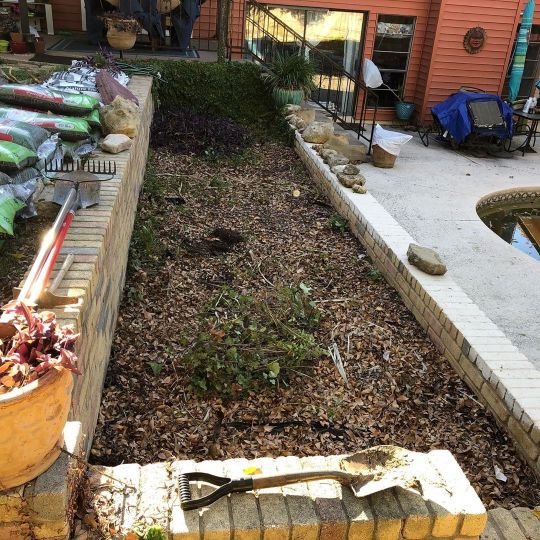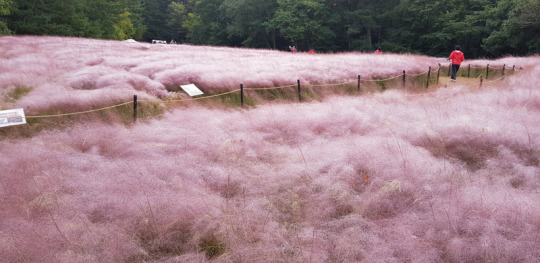#is pink muhly grass invasive
Text
Is Pink Muhly Grass Invasive?
Is Pink Muhly Grass Invasive?
Very few grasses boast a low maintenance characteristic and pretty pink blooms than the Pink Muhly. But before you get this for your garden you might be tempted to ask, ‘is pink muhly grass invasive?’
Let’s learn more about this pretty and hard working plant.
Is Pink Muhly Grass Invasive?
All signs point to Pink Muhly being an invasive species, but you’ll be glad to know that it’s not…

View On WordPress
0 notes
Text
I just want to clarify, in case there are ecofascists looking upon my blog, that I do not recommend planting native plant species because I think non-native plants are bad, but rather because native species in your area are probably dwindling or endangered, which means the animals that live in your area are starving and need to move away, or die. You live in an ecosystem, regardless of if you live off the grid or in a city. You aren't alone, and ensuring the animals you're neighbours with have enough food is something you're capable of.
Invasive species can be detrimental to the local environment because they grow quickly + dont have predators to keep them in check, but naturalized and otherwise non-native species? Totally fine, especially if you want to consume it! If you want to grow watermelons in your Florida garden? Go for it! You want Pink Muhly grass to replace your lawn in Korea? Have at it!
But if you can, provide for your local wildlife too. You might be one person, but you can have an incredible impact on those around you, like Tim Wong who saved a rare species of butterflies, and Jadav Payeng who built a forest.
54 notes
·
View notes
Photo

Stripping planting areas of landscaping fabric is just as important as ridding areas of non native invasive species. This weekend we did both. And replaced with native grasses (Big Muhly & Gulf Muhly). Once grown in (usually one season), this will be an area with purplish pink and golden hues. Native grasses are wonderful for pollinators, as many grass skippers use them as host plants. And birds use the leaves too for nest building. #NativesForWildlife #NativesAreImportant #PocketPrairie #NativePocketPrairie #NativeGrasslands #EcoregionsMatter #TheNectarBar #PlantNative #PeaceLoveAndButterflies #Butterflies #NativePlants #Nature https://www.instagram.com/p/B6G2FEenXqp/?igshid=1xlq0tnn4n315
#nativesforwildlife#nativesareimportant#pocketprairie#nativepocketprairie#nativegrasslands#ecoregionsmatter#thenectarbar#plantnative#peaceloveandbutterflies#butterflies#nativeplants#nature
0 notes
Text
[Weekender] The pink invasion
[Weekender] The pink invasion
ศาสตร์เกษตรดินปุ๋ย : ขอบคุณแหล่งข้อมูล : หนังสือพิมพ์ The Nation
https://www.nationthailand.com/travel/30377100
[Weekender] The pink invasion Oct 05. 2019

This file photo from last year shows a pink muhly field in the southern port city of Ulsan. (Yonhap) By Lee Sun-young
The Korea Herald
833 Viewed
Exotic imported pink grass is the star of autumn gardens
Pink is the most sought-after…
View On WordPress
0 notes
Text
Before settlers crossed the Mississippi River and literally ran for 160-acre plots in one of several Oklahoma land runs in the late 1800s, much of the territory’s western half was covered in mixed prairie grasses. In what became Oklahoma Territory, the Osage, Cheyenne, Arapaho, Kiowa, Comanche and Apache tribes hunted bison and other animals. Oklahoma’s diverse landscape, including its glorious grasses, made such hunting possible because prairie and forest plants provided cover and forage for animals like bison, elk, bear, rabbits, squirrels, turkeys, and white-tailed deer. On the eastern side of Indian Territory, the land was wooded with blackjack oaks, eastern cottonwoods, post and pin oaks, and many other tree species. Being rocky and hard to develop, much of it is still very wooded today.
1892 Map of Oklahoma and Indian Territories courtesy of the Library of Congress.
I live at the junction between the prairie and the forest in what is now Logan County, a green section at the center of the map above. Each day, I wake up grateful that I own 7.5 acres of land where I continue to work in a garden that’s become a pollinator and bird habitat. Lizards, snakes and frogs like it too. It’s always a work in progress, and that’s what makes gardening such a fascinating hobby. You never run out of things to learn.
And, one thing I’ve learned over the last ten years is that glorious grasses help me build my own little corner of the prairie.
[Click on photos in the galleries to make them larger.]
Grasses and other plants in my garden midsummer of 2013. It looks similar now, but the chairs are painted purple. I could no longer find French blue paint.
Pennisetum purpureum ‘Fireworks’ with Phlox paniculata ‘Bright Eyes’ behind. See how great they go with my purple chairs?
Tallgrass prairie once covered 14 states throughout the central part of the United States. On November 12, 1996, the Nature Conservancy purchased the Chapman-Barnard Ranch covering 29,000 acres near Pawhuska, Oklahoma. This purchase helped form what is now the 39,650 acres of the Joseph H. Williams Tallgrass Prairie Preserve near Pawhuska, Oklahoma, once part of the Cherokee Outlet and the Osage lands in the above map and stretching into southern Kansas.
Bill and I have visited the Tallgrass Prairie Preserve numerous times in various seasons. It is a source of respite and inspiration to me in my own garden. I especially notice this In late summer and early fall. Grasses that have been providing background support for the rest of our landscape now take center stage. Ornamental grasses are at their full height and sport fully-formed seedheads. The prairie is a thing of true beauty in any season, but in fall, it is magical. Ornamental grasses breathe life into a garden. Let them breathe life into yours.
Good old Miscanthus sinensis, maiden grass in my garden. It is next to Blush Knockout rose. Although M. sinensis is invasive in some parts of the U.S., it has never moved from this spot in my garden. I also use ‘Adagio’ in another spot.
How can you replicate some of the tallgrass prairie for your home? One way is by strategically planting grasses. Although the Great American Prairie is composed of a multitude of plants, grasses are its living backbone providing structure for three seasons out of the year. The only time ornamental grasses don’t look good is in late winter/early spring when just cut back. However, the plants surrounding them will shelter grasses until they begin to grow. Grasses are relatively unobtrusive unless you have an entire row of a particular grass as I do with my pink muhly grass.
Muhlenbergia capillaris ‘Lenca’ Regal Mist, pink muhly grass, with Salvia leucantha, Mexican bush sage peeking through.
Even then, the grasses don’t look bad. They just don’t look like anything.
Bouteloua gracilis ‘Blonde Ambition’ blue grama grass. I grow it in pure gravel, and only water it occasionally in summer.
Many varieties of grass are simple to grow. In fact, in some climates, they can be invasive, but we haven’t seen that in Oklahoma. You can grow many by seed, or by purchasing container grown plants in the spring or fall. Although I have grown some by seed, I prefer to buy plants to get things more quickly established. Some of the ones I grow are native. Others are not. I tend to choose grasses based upon what I need in a particular space. I then surround them with other prairie plants attractive to pollinators and birds. Although I still love roses and grow them, Rose Rosette Disease wiped out many of my rose shrubs. I will never plant a rose in the same spot for a variety of reasons, and I’ve found grasses are wonderful for rose replacement although I’ve also planted numerous fruiting shrubs for the birds too.
Grasses require some garden work, but it isn’t onerous.
Pennisetum alopecuroides ‘Ginger Love’ is a dwarf fountain grass that I love more than ‘Hameln,’ although I grow ‘Hameln’ too.
Grasses come is many different heights. Among the shortest are Pennisetum alopecuroides ‘Hameln’ and ‘Ginger Love’ dwarf fountain grasses. I love these small grasses for the front of the garden bed. In fact, I bought two more one-gallon containers of ‘Hameln,’ and I’ve planted them in the front of the garage border. Schizachyrium scoparium ‘Standing Ovation’ is a shorter little bluestem grass. I have trouble growing bluestem grasses, tall or small, in my garden probably because I water more than they like. I use drip irrigation, but I also have years like this one where Oklahoma received tons of rain. Bluestem grasses do not like too much rain or enriched soils. I have both at various times. I also can’t grow Festuca glauca ‘Elijah Blue’ fescue.
No one can grow everything, and that’s okay.
Panicum virgatum ‘Northwind’ up close. See all those shades of yellow?
P. virgatum ‘Northwind’ turning bright yellow.
P. virgatum ‘Heavy Metal’ with a crapemyrtle behind.
I have tremendous success with the native switchgrasses, and I grow several from tall ‘Northwind’ to the shorter ‘Heavy Metal’ and ‘Cheyenne Skies.’ At eight or nine feet, ‘Cloud Nine’ is one of the tallest switchgrasses available. At the present time, panicums are probably my favorite grasses. They’ve performed so well in the garden that I’ve been able to split them several times. All of the switchgrasses turn beautiful colors in the fall with some being more yellow and others more purple. They are perennial.
Rosa ‘September Song’ with P. virgatum ‘Cheyenne Skies’ behind it.
Speaking of purple grasses, for pure theater, I don’t think you can beat Pennisetum purpureum ‘Fireworks.’ I’ve grown this grass in pots on the deck and in the borders for years. I especially love it with coleus and Phlox paniculata ‘Bright Eyes.’ Such a beautiful combination. Purple fountain grass is not perennial in Zone 7, but also check out ‘Princess Caroline’ for a large focal point.
Pennisetum purpureum ‘Fireworks’ with Phlox paniculata ‘Bright Eyes’ behind. See how great they go with my purple chairs?
Pennisetum purpureum with purple heart and coleus at Bustani Plant Farm.
Another view of ‘Campfire’ coleus and purple fountain grass in the terraces. The trees are still small, but they will get bigger each year eventually providing windbreaks and shade.
The very gorgeous Pennisetum ‘Princess Caroline’ is a showstopper next to Hibiscus ‘Maple Sugar’ and Senorita Blanca® cleome.
Dramatic dark grass at OSU Botanical Gardens. Might be ‘Princess Caroline’ or Vertigo.
If you want a nice tall grass with large plumes, consider Calamagrostis x acutiflora ‘Overdam,’ a variegated selection. If you can’t find ‘Overdam,’ try ‘Karl Foerster.’ I’m growing it along a fenced border in the back garden as a kind of screen. It’s going to take a while to fill in. I like larger grass clumps at the edge of my gardens because they dissuade deer from entering the space. They don’t like the swishing noise or that they cannot see.
Calamagrostis x acutiflora ‘Karl Foerster’ with the very late-blooming and tall Hemerocallis ‘Autumn Minaret’ daylilies.
Calamagrostis x acutiflora ‘Overdam.’ In front of the grass is Penstemon smallii ‘Violet Dusk.’
I mustn’t forget Mexican feather grass either. Although it is invasive in some climates, it is well-behaved here. I do have to replant it periodically because it tries to die out. I love how the plumes swish with the wind. Is there anything better?
Mexican feather grass and other plants, native and non-native make up a the palette used by Piet Oudolf.
Phlox divaricata, woodland phlox with Mexican feather grass planted in a shallow border. I lined the border with Nassella tenuissima, Mexican feather grass because it softens the concrete.
Nassella tenuissima, Mexican feather grass, planted along the edge of a border softens the concrete blocks.
Side border next to the deck has Tightwad Wad crapemyrtles, Little Lime® and Quick Fire® hydrangeas. There are also daylilies and Mexican feather grass in this border.
Try some glorious grasses in your garden, and you’ll see what I mean.
Glorious grasses Before settlers crossed the Mississippi River and literally ran for 160-acre plots in one of several Oklahoma land r…
0 notes